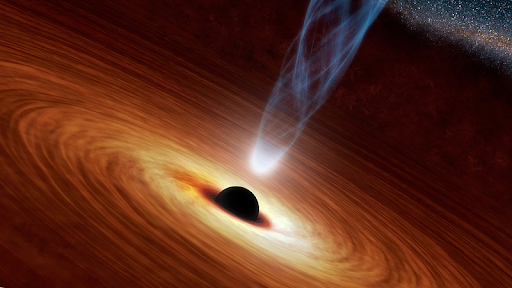Supermassive black hole seen spinning ropes of plasma like a cosmic spider
A 570-light-year-long twisted jet of plasma is getting blasted from a distant blazar at near the speed of light.

Like a monstrous cosmic spider, a distant supermassive black hole is spinning a jet of plasma into a twisted rope and blasting it out at near-light speed.
Astronomers witnessed this spectacular sight with a network of radio telescopes, including the RadioAstron space telescope, that are combined to form an Earth-sized antenna. Specifically, this network was trained to observe the heart of a distant blazar named 3C 279.
These observations comprise the most detailed look scientists have ever had of an astrophysical jet emerging from a supermassive black hole, revealing a complex, twisted pattern near the jet's source. This new picture could challenge currently accepted theories that, for 40 years, have been used to explain how these jets are created and how they evolve over time.
"Thanks to RadioAstron and a network of twenty-three radio telescopes distributed across the Earth, we have obtained the highest-resolution image of the interior of a blazar to date, allowing us to observe the internal structure of the jet in such detail for the first time," Antonio Fuentes, team leader and a researcher at the Institute of Astrophysics of Andalusia (IAA-CSIC), said in a statement.
Related: Weirdly wobbly jets may be evidence of elusive supermassive black hole pairings
A space spider's 570-light-year-long web
Blazars, such as 3C 279, are the bright hearts of galaxies that emit powerful light as the result of hosting a feeding supermassive black hole. Here's what that means.
Actively feeding black holes in the centers of galaxies continuously churn the matter they feast on, and this material is situated in the form of flattened plates of gas and dust around the voids. Those plates are called "accretion disks." Altogether, such scenarios are collectively known as active galactic nuclei. Active galactic nuclei are often so bright they outshine the combined light of every star in the galaxies surrounding them.
Breaking space news, the latest updates on rocket launches, skywatching events and more!
But around 10% of active galactic nuclei blast out astrophysical jets during the whole feeding process. These are known as quasars — and when those quasars have jets aimed directly at Earth, they're called blazars.
The new observations of 3C 279 reveal unprecedented details of the plasma jet and the supermassive black hole at the heart of this blazar. "This is the first time we have seen such filaments so close to the jet’s origin, and they tell us more about how the black hole shapes the plasma," Eduardo Ros, another member of the team and European scheduler of the Global mm-VLBI Array, said in the statement. "This shows how different telescopes can reveal different features of the same object."
In particular, the team found the jet to be composed of at least two twisted filaments of plasma that stretch over 570 light-years from their source. The observations also showed the plasma jets are not straight and uniform; they exhibit twists and turns that arise as a result of the central black hole’s influence.
The twists, or helical filaments, are the result of instabilities in the plasma jet, which is part of what implies prior theories of how these jets evolve may need to be revised. This research could also revise our understanding of the role magnetic fields play in the initial formation of near-light speed jets from active galactic nuclei.
"One particularly intriguing aspect arising from our results is that they suggest the presence of a helical magnetic field that confines the jet," Guang-Yao Zhao, one of the team's members and a scientist at the Max Planck Institute for Radio Astronomy, said in the statement. "Therefore, it could be the magnetic field, which rotates clockwise around the jet in 3C 279, that directs and guides the jet’s plasma moving at a speed of 0.997 times the speed of light."
The research demonstrates there is a lot left to learn about blazars and their jets, and that there's a need to build more accurate models of the process at play around feeding supermassive black holes. It also emphasizes the importance of improved radio telescopes and development of techniques to image distant cosmic objects in greater detail.
"We are entering an entirely novel terrain in which these filaments can be actually connected to the most intricate processes in the immediate vicinity of the black hole producing the jet," Andrei Lobanov, one of the team's members and a scientists at the Max Planck Institute for Radio Astronomy, said in the statement.
The team’s research was published on Thursday, Oct. 26, in the journal Nature Astronomy.

Robert Lea is a science journalist in the U.K. whose articles have been published in Physics World, New Scientist, Astronomy Magazine, All About Space, Newsweek and ZME Science. He also writes about science communication for Elsevier and the European Journal of Physics. Rob holds a bachelor of science degree in physics and astronomy from the U.K.’s Open University. Follow him on Twitter @sciencef1rst.

